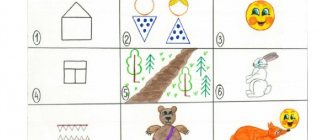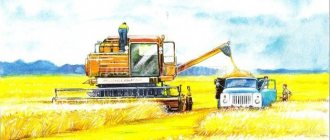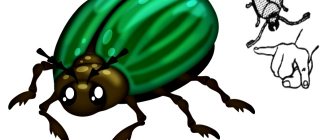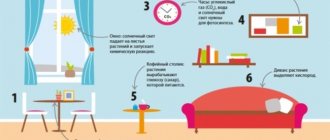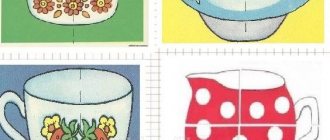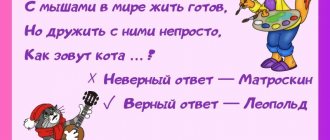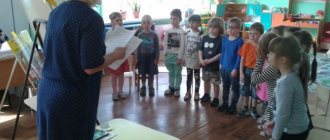Child up to six months
Babies of this age are in inextricable unity with their mother. Only if there is close spiritual and physical contact with her, the social situation will be comfortable for the child.
The main, leading type of activity of a child in infancy is direct emotional communication , the subject of which for the child is an adult. The first social need that is formed in a child is the need for another person, the development of which parents need to pay special attention to: they need to talk to the child, smile, tell him fairy tales. The baby still does not understand everything that an adult tells him, but this should not be a reason for embarrassment. Psychologists say: “A baby is helpless if he is alone, but a pair of “mother and child” is not only not helpless, but amazes with its vitality.”
A fairy tale that a mother tells a child of this age can be called a fairy tale only conditionally, because its plot is absolutely not important for the child. A fairy tale becomes one of the components of complex contact with a child. Here, the mood, emotional state, and intonation pattern of the narrator’s speech acquire special significance, because through intonation the child “absorbs” the adult’s state and feels his attitude towards himself. The words can be anything; as a rule, the words reflect some kind of interaction with the child.
For example, when doing gymnastics:
Let's stroke the arms up and down, up and down, stroke the legs up and down, up and down, and now the tummy - in a circle left and right. Let's catch mom's fingers: grab-grab-grab! We wave our arms forward, up and to the sides. Who is mom's athlete? Forward, upward and sideways.
This fairy tale game does not have a clearly defined beginning and end, so it can last as long as the game is interesting to the child.
Speech is accompanied by appropriate movements, the contact between mother and child becomes complex: the baby sees the mother, hears the intonation of her voice and feels touch. Thus, the inextricable unity of mother and baby is achieved, which is so necessary for a child of this age.
What obstacles must the Hero of the written fairy tale overcome?
- solve a small or big problem,
- reach some destination as a result of travel,
- help yourself, a family member or simply save a person,
- fulfill the dream,
- get an answer to a question
- break the spell
- to cure or to be cured?
- find a friend or loved one.
How the Fox was fooled
Then the gate opened, and the owner of the bast hut, the Fox, came out. “Why, redhead, are you lost in the forest? Why didn’t you spend the night at home?” The fox answers: “I went hunting, but I hesitated in catching a purebred guinea fowl. Now it’s too late for me to return home. If you let me into the yard, I’ll sell you my loot at a good price.” “And what will your price be, gossip?” “For ten gold pieces I’ll give you the whole thing, plus a cabbage leaf,” answered the Fox. “Okay, then come in,” answered the Fox. The redhead went into the bast hut, where the stove was just flooded. And she was so exhausted that she fell asleep right there on the bench.
In the morning the Fox woke up, and meanwhile the Fox was taking care of the housework and getting ready to hunt. “What is the owl science here?” — the redhead began to think. And the Fox says to her: “Well, if you’ve had enough sleep, godfather, then drink milk from the jug to the bottom. And pack your knapsack and leave the hut already - it’s time for me to go hunting.” “What about the chicken?” - asked the Fox. “And keep your prey for yourself, you see, I am a noble Fox, always ready to shelter a wanderer.”
The fox went home. Look along the road - there is no guinea fowl in her knapsack. There are no morocco boots either - she has birch bark sandals on her feet. The deceived gossip said to herself: “Why did I have to deal with this Fox?” It was then that she remembered the words of the wise Owl, and the Fox began to work on correcting her character.
Place the hero of your short fairy tale in a specific time and space
Consider whether your story takes place in a real or fictional world.
Now? A long time ago? Or in the distant future?
How long will it take the hero to overcome all difficulties and achieve his goal?
A day, a few years, a century?
Place your character in a familiar or, conversely, unusual environment.
Keep it simple. You can, for example, place the hero in your apartment and imagine a living room filled with cozy armchairs and sofas with cushions. Or the kitchen. Or a nursery. Or a yard.
Remember to include all your senses. And to do this, go inside your hero or heroine and imagine.
- What do you see: a key, a strange object, a piece of paper, a letter, an inscription from the clouds?
- What do you hear: the ticking of a wall clock, the movement of cars on the street, barely audible steps?
- What smell bothers you: a strange aroma, a burning smell, a sweet aroma of cookies?
- What do you feel: a breath of wind, chills, goosebumps, the warm touch of a ray of sunshine?
- Maybe the taste of hot milk or the metallic taste of fear appeared in your mouth?
Secret 4. How to make a homemade book with a children's fairy tale?
I always put children's fairy tales into homemade books. I fold the album sheet in half. It turns out to be a “book” of 4 pages. The first page is the cover. A child draws it. On the cover we sign the name of our fairy tale. We make sure to choose a title that makes it clear what the fairy tale is about. The next three pages are the fairy tale itself: its beginning (second page), middle (third page) and end (fourth page). I write the text at the bottom of the page from dictation. And the child draws pictures.
The child quickly forgets his actions, especially his words. Speech is generally a phenomenon that cannot be touched, stroked or felt in any way. Such books show the child the visual result of his speech, his efforts and arouse great interest among all children. After all, this result is beautiful, you can show it to a friend, dad, grandma, stroke it, touch it!
Honestly, I have not seen a single small child who would refuse to compose a fairy tale and publish his own book based on it, in which he will be both an artist and a writer. Moreover, even the most active and hyperactive preschoolers are ready to engage in this exciting activity for hours!
Your little fairy tale should have a happy ending
Even though we don't always get what we want in real life, the world of fairy tales makes us believe that anything is possible.
Try these ideas:
- the main character of the fairy tale saves himself, his family or someone else,
- the hero solves the puzzle and reveals the secret,
- the main character overcomes obstacles and his character or character trait changes,
- the main character becomes happier, richer, smarter, he has friends.
The redhead hits the road
A fairy tale about animals, invented by children, should also have an instructive component. The Fox was surprised by Owl's advice. I thought about it and decided to obey: who wants to while away their life in girls! So she packed her knapsack, combed her fluffy red fur coat, put on her morocco boots and set off for distant lands. She walked past a distant lake, a forest, and a neighboring village. Behind that village the forest was completely dark. She sees a bast hut standing on the edge of the forest, decorated with paints and flowers. She knocked on the door - no one answered. Then the redhead began to knock even louder, until a voice was heard from the hut: “Who is bothering me there with their noise?” “It’s me, the red-haired gossip, coming from distant lands, looking for shelter for the night. Whoever lets me in for the night, I’ll sell him a good product, a rare one – a chicken of a special breed.”
What happened to the Hero or Heroine?
Please note that most fairy tales of all times use the idea of "a lady in trouble" or "a boy in trouble." These ideas always work!
Write what happened to the main character
- unusual phenomenon
- the villain conjured something,
- some action shifted the balance,
- disease,
- stealing something vital,
- a loss,
- poverty and the need to survive,
- a task to save or protect someone, perhaps the whole world.
Come up with goals
- What goal does the hero set for himself?
- what actions does he need to take to achieve his goal?
- What makes him go towards his goal: love? justice? Liberty? compassion? looking for adventure? Security and fear? self-realization?
The raccoon gave up
You can quickly come up with a children's fairy tale about animals if you give its characters the qualities of people. The main character of this fairy tale has characteristics inherent to a person. After all, people also love to celebrate the New Year. The raccoon went on the road. But while he and his aunt were combing his tail, a dark night fell. “It seems like we need to turn here...” the Raccoon thought. “Or maybe not here, but there...” The road seemed completely confusing to him. Moreover, the Moon hid behind the clouds - darkness in the forest set in, even if you gouge out your eyes.
Poor Raccoon got completely lost. There are only a few hours left until the New Year. He ran and ran and fell into an icy ditch. “That’s it,” thinks the Raccoon. “I won’t be able to make it in time for the holiday.” He lay down at the bottom of the hole and decided to go to bed. But as soon as he closed his eyes, a little Mouse ran across him. “Stop waking me up! - said the Raccoon. “Don’t you see, I’m sleeping.” “So you’ll probably sleep through the whole holiday,” answered the Mouse in a squeaky voice. “And I’m not going to the holiday. I don't need him, okay? Don't you see, I'm sleeping. Leave me alone". “I would leave you alone,” says the Mouse, “but I’m collecting the remains of cheese in my underground passages for a New Year’s pie, and you’re lying right across my road.” She said and darted into the hole.
Child from one to two years old
At the age of one to one and a half years, the complete unity of the baby with his mother explodes from the inside. Two independent people appear: the baby and the mother. The crisis of the first year of life lies in the child’s awareness of this change. At this age, the little person acquires a certain degree of independence: the first words, the first independent steps, the first conscious actions with objects. However, the baby's range of capabilities is still very limited.
At this age, the child’s words are still situational. His speech is already a means of communication and expression of desires and emotions. At the same time, it is still devoid of constant meanings - the same word or combination of sounds can be used to name a wide variety of objects, actions or phenomena.
The child himself is not able to find out how to properly use this or that object. How to hold a spoon? How to put on glasses? How to use a comb? Therefore, in almost every action that a child performs with this or that object, there is, as it were, an adult who shows and explains to the child the essence of the object. Therefore, communication at this age becomes a form of organizing objective activity . It continues to develop extremely intensively and becomes not only emotional, but also verbal.
A fairy tale for a child from one to two years old becomes longer in time. The story can last as long as it takes to study an interesting subject; the plot includes the active actions of the child himself. The game can be completed at any time as soon as the little listener has lost interest, and can be returned to it another time when a mutual desire arises.
Through fairy tales, norms of behavior, necessary self-service skills, as well as a general broadening of one’s horizons can be taught. At this age, fairy tales associated with certain rituals may appear. For example, a fairy tale that accompanies the process of brushing your teeth.
Once upon a time there lived little teeth in a house-mouth. And there were them... Open up, little house mouth! ... one, two, three, four, five, six, seven... The teeth decided to invite a brush to visit them. And the brush called with it some paste and a glass of water. They came and began to greet each tooth, the brush rubbed each one with its bristles on one side and the other, and on the back too. The teeth are ticklish and they laugh. After the brush came some water and rinsed each tooth. The teeth became clean and shiny. This is where the fairy tales end, and the one who listened will have strong and healthy teeth!
